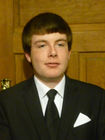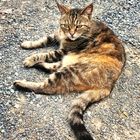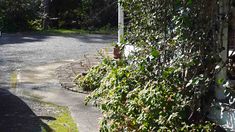Federal Commonwealth of Sirocco
This article contains too many red links, and may be going through a major copy edit. You can help by clicking on red links and creating articles or by removing unnecessary red links. |
Federal Commonwealth of Sirocco Bunderahl Condorate ver Siroka Truwei Weiar en' Seruco | |||||||||
|---|---|---|---|---|---|---|---|---|---|
Flag
| |||||||||
| Motto: Nemine Contradicente Latin: Without opposition | |||||||||
| Anthem: Shelter | |||||||||
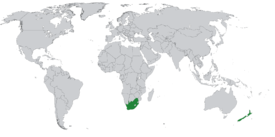 New Zealand; South Africa | |||||||||
| Capital | Havilland | ||||||||
| Largest city | Chide | ||||||||
| Official languages | English, Siroccan, Edallic | ||||||||
| Demonym(s) | Siroccan | ||||||||
| Government | Federal republic under a parliamentary system with an executive presidency | ||||||||
• Premier | Daniel Anderson | ||||||||
| Legislature | Siroccan Executive | ||||||||
| Establishment | 4 November 2010 | ||||||||
| Population | |||||||||
• (January 2013) census | 54 | ||||||||
| Currency | Simoleon | ||||||||
| Time zone | GMT+2 GMT+12 GMT+13 (DST) | ||||||||
Website Official website | |||||||||
| |||||||||
Sirocco is a member of TASPAC. | |||||||||
Sirocco, officially the Federal Commonwealth of Sirocco (si-ROCK-oh; Siroccan: Bunderahl Condorate ver Siroka, Edallic: Truwei Weiar en' Seruco), is a federal micronation located in New Zealand and South Africa. The nation consists of fourteen provinces while the capital (although not the largest city) is Havilland. Sirocco covers an area of several square kilometres and has a subtropical seasonal climate. The nation is well known for its somewhat peculiar culture, the most famous elements of which being trams and a national fixation with the 1950s, although in its western provinces there exists a culture resembling that of feudal Japan. With a population of 54, it is one of the largest micronations by population in Oceania and the largest in Africa. It is one of the major political and cultural micronational powers of the Oceania region, and to a slightly lesser extent, the greater MicroWiki community.
From a period between the 1000s and 1400s Maori tribes settled in the Northland and Auckland areas of New Zealand before the establishment of a British colony on 6 February 1840. In 2002, an area in the mid-north area of Northland became constituted as the "Maran District", complimented by the Kingdom of the Peebles which was founded in 2006, before both became inactive by mid-2007. On 4 November 2008, the Glorious Dictatorial Republic of Andersonia was proclaimed, which ran as an Orwellian totalitarian state primarily based online. By mid-2010, it became obvious the state's power and influence was declining, and so in August of that year work began on a successor state, which culminated on 4 November 2010 with the formation of the present Federal Commonwealth of Sirocco. Initially Sirocco controlled territory in both New Zealand and Australia, but on 20 April 2011 its Australian territories were dissolved and activity focused on New Zealand. Throughout 2011 Sirocco's influence in the community grew through political and cultural activities, and on 21 March 2012, the Zonian Confederacy was absorbed into Sirocco as three new provinces, giving the nation African territory for the first time.
Sirocco was a founding member of TASPAC in January 2011, and is a fifth-world micronation under the Boodlesmythe-Tallini system.
Etymology
Sirocco was originally known as 'Andersonia', a reference to an internet micronation Daniel Anderson founded in 2008, which was named after him. As work began on a successor state to the Glorious Dictatorial Republic of Andersonia, the "Federal Commonwealth of Andersonia" was used as a working name. The name stayed for just over a month before it was changed to "Sirocco" on 3 October 2010.[1] The name 'Sirocco' comes from the southeastern Mediterranean wind, however the name was also chosen for its likeness to a true national name. Sirocco's full name may be abbreviated as SR (for Sirocco) or as FCS (for Federal Commonwealth of Sirocco) where needed. In languages where the word "commonwealth" is not used, the nation's full name may be given as the Federal Republic of Sirocco.
Sirocco's Siroccan and Edallic names (Siroka and Seruco, respectively) are direct transliterations of the state's English name.
History
Maran District and Kingdom of the Peebles
Sirocco's earliest roots are in the former Maran District (2002-2007). The Maran District was a fictitious territorial authority based in the mid-north area of Northland.
Glorious Dictatorial Republic
The idea for Sirocco first began with the Glorious Dictatorial Republic, or GDR, in 2008. It first occurred to Premier Anderson the thought of his own nation (although the concept of a micronation hadn't occurred to him yet), and in November 2008, the GDR began. There is some animosity as to the actual date of the foundation, with dates ranging between 3 November 2008 and 20 November 2008, however the date is generally accepted to be November 4. During this early period, the GDR began rapid expansion, although actual physical territory was not claimed. There were several opponents to the regime, although there were supporters, several of whom have consented to becoming Ministers within the FCS. During 2009 and 2010 there were many battles and clashes won against the aggressors, however a period of inactivity ("down-time"), was noticed around late 2009-early 2010.
Activity within the GDR had declined sharply since the Sirocco Times announced on 30 August 2010 that a new micronation was going to be formed.[2] Throughout September work began on the formation of the new Andersonia, including the establishment of a national newspaper and the beginning of the composition of the Constitution. In mid-September 2010, it was announced that the Premier had begun choosing members of the Board of Ministers, as well as establishing Andersonia's claims in New Zealand and Australia. On 3 October 2010, Andersonia was formally renamed Sirocco to distinguish the incoming state against the outgoing one,[3] while on 11 October 2010, it was reported that a §40,000 grant had been forwarded towards the creation of the new micronation.[4] The following day it was announced that Anderson had chosen the first Board of Ministers for Sirocco.[5] Finally, on 31 October 2010, the Constitution of the Federal Commonwealth of Sirocco was completed, smoothing the way for the November 4 foundation. However just two days before foundation a scandal erupted in Sirocco, threatening the stability of the entire government.[6] However within a matter of hours the problem had been resolved and preparations for the formation of Government complete. At 11:03am NZDT 3 November 2010, Anderson signed the GDR Dissolution Act 2010, formally ending the Glorious Dictatorial Republic of Andersonia after 1 year and 364 days of existence.[7]
Early Sirocco
The gap formed after Andersonia's end was quickly filled when at 11:13am NZDT on 4 November 2010, the Federal Commonwealth of Sirocco was officially founded by Anderson after being sworn in by Vice-Premier Jesse Coles. The Siroccan government then moved quickly to assimilate itself into the community, which welcomed the new arrival warmly. It was at this time that numerous diplomatic relations were formed, notably with A1, St.Charlie and Yabloko, widely recognised as three of MicroWiki's most influential micronations at the time. Sirocco's early strengths were reflected in its placement as the fourteenth most influential micronation in a survey conducted in January 2011. Through January, Zealandian First Minister Sebastian Linden was seen by many as a troublemaker, and in an attempt to rid Zealandia of him, a brief war was fought on 28 January 2011 which ended in a Siroccan victory. After the signing of the Treaty of Alston the same day, Zealandia was merged into Sirocco, which had renamed to become the "Federal Commonwealth of Sirocco and Zealandia", a nation virtually identical to Sirocco despite Zealandia playing a major part in the union. The union collapsed the next day after Zealandia withdrew, prompting a suspension of relations and the near-collapse of Zealandia itself. Zealandia was dropped from the national title and Sirocco readopted its original name of the "Federal Commonwealth of Sirocco". It was on the same day that the Garden River, Alston's main waterway, overflowed for the first time in Siroccan history (although it had burst its banks many times before during the time of both Maran/Peebles and Andersonia), on 28 January 2011. The flooding closed Tent Pegs Road and nearby Ianson Island was engulfed, cutting access to the island. However damage was minimal and roads were open the following morning.
The early successes of Sirocco soon began to fade as less and less activity came out of the nation. While hopes had been raised on 3 February 2011 that the inactivity that had plagued the Board of Ministers had come to an end, it was soon realised that this was not to be the case. Following this good news, a new coat of arms was unveiled on 14 February to try and stimulate major reforms scheduled to take place, however Siroccan inactivity soon began to increase. Sirocco notably took part in Operation Electrolight on 1 April 2011, albeit in a relatively minor role, and was criticised for its participation. It has been suggested that this action may have sent Sirocco into near-inactivity over the next two months, as well as the dissolution of several provinces. While two episodes of the hit comedy series Micro High were produced by the SBC, the inactivity was most well-represented by no articles by the Sirocco Times for over two months. Realising that Sirocco was nearing complete inactity, Anderson began a major campaign to restart Siroccan activity in July 2011, starting with the production of Micro High's third episode and the creation of documents pertaining to the city of Alston. On 8 July 2011, Anderson announced that "no longer will Sirocco stay quiet, if it is to be a success it must be a leader, and that requires things to do. Sirocco is back on track."
Rising influence
In early March 2012, it was reported that the Zonian Confederacy was looking to merge with another micronation. By 5 March, it had come down to a decision between the Federated Republics of A1 and Sirocco. While it was expected that A1 would win the vote due to their online storage capabilities, a Parliamentary session saw a majority of members vote to join Sirocco.[8] Zona formally became part of Sirocco on 21 March 2012 as the Dominion of Zona. On 28 March 2012, Sirocco was threatened by an overland invasion for the first time when a group of rowdy teenagers descended on a border fence in the Tent Pegs National Forest.[9] A tense standoff between the teenagers and the Siroccan Defence Forces saw the teenagers withdraw, and the first and so far only threat to Sirocco passed quietly.
Sirocco's rise in the MicroWiki community continued on 11 May 2012 when Sirocco was ranked sixth on the ninth MicroWiki Influence Survey, behind St.Charlie, Nemkhavia, Austenasia, Wyvern and Renasia. While in later surveys its position dropped to its current ninth placing, Sirocco is still considered one of the community's most powerful and influential nations.
Modern
Although Sirocco has held territory in Auckland, New Zealand's largest city, since its creation, it was not until 2013 that the Auckland provinces took on a more prominent role in national affairs. This was a result of a noticeable population shift southwards from the Northland provinces, and led to the cities of Bradford, Havilland, and Rathlyn all serving as
Politics
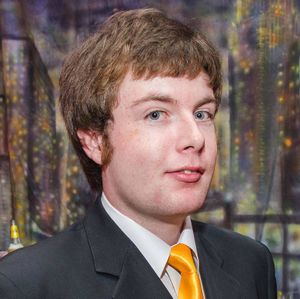

Sirocco is a republic with a federal division of powers. It uses a system based somewhat on a parliamentary system, however the Siroccan government has most of its authority vested in a Premier, currently the nation's founder Daniel Anderson, who is both head of state and head of government. Below the Premier is the national legislature, the Siroccan Executive, comprised of twelve seats—eleven for each province and one for the dependencies. The Executive is used to introduce and debate legislation, however ultimately the power to pass or reject national laws is vested in the Premier. Sirocco's government, officially known as the "Siroccan National Government", is based in the country's capital, Havilland.
Historically Sirocco also had a Chancellor, meant to represent the Executive's predecessor, the Board of Ministers. Between 5 May and 5 August 2011, Charlotte Lindström served as Sirocco's first and only Chancellor, before resigning after 93 days after being reprimanded by Anderson for attacking the incumbent Federal government.
Political parties
Sirocco currently has two political parties—the conservative Federal party, headed by Daniel Anderson and the classical libertarian Libertarian party, led by Nicholas Woode-Smith. Currently the Federal Party is in power with nine seats in the Executive, as opposed to the Libertarian opposition with three. Each party has its own "safe seats"—for the Federal party these are the provinces and dependencies located in New Zealand, while the Libertarians easily hold the South African territories.
Government
-
Jesse Coles:
Vice-Premier
Minister of Enterprise, and Finance,
Ambassador to Australia
Foreign relations
Sirocco has a network of diplomatic relations with 23 nations. It is closest with many of its regional and ideological partners, and relations are generally good between Sirocco and many of the MicroWiki community's members. One notable example is with the Kingdom of Zealandia, which has had a rocky relationship with Sirocco for some time.
Provinces
Sirocco has twelve provinces—Bolton, Cambria, Chai, Falkirk, Halvorson, Hobson, Jellicoe, Konson, Trafalgar, Wellesley, Weymouth and Zageta. Each of these provinces are highly autonomous—each has its own provincial government and may set its own laws pertaining to the confines of that province, however the federal government does have power to override any provincial legislation. While matters such as seat of government, flags and highway designation are managed by the federal government in Havilland, provinces are free to construct, maintain and/or demolish infrastructure, manage a policing force and create local governments, known as territorial authorities.
Each province is represented in the national legislature, the Siroccan Executive, by one person known as an Executor who is either elected or appointed by the federal government. This person is unofficially 'head' of the province and its government, and in extension to managing their province may also voice opinions and concerns of the provincial populace to the national government.
Since March 2012, Sirocco has controlled territory in Cape Town, South Africa. The three provinces located here are Chai, Konson and Zageta, which collectively are known as the Dominion of Zona.
The federal government also directly maintains other parcels of land, usually without a permanent population, which do not have the same levels of autonomy as their provincial counterparts. These are divided into Territories (usually larger) and Dependencies (usually smaller). Currently Sirocco has no territories since Halvorson was elevated to Provincial status in December 2011, however it does control five dependencies, these being Blacksands, Castor, Gillies Island, the Muldoon Protectorate and the Watchman Island Dependency.
Below the Provincial system exist thirteen territorial authorities, responsible for maintaining small sections of the province—for example, Cambria is divided into the Maran District in the south, Alston City in the centre and the Ackland District in the north. This system did lead to some confusion when the province was known as the National Capital District due to its name - however the territorial authority system was not implemented until the middle of 2011.
| Name | Capital (or largest settlement) |
Population |
|---|---|---|
| Minnerichell | 4 | |
| Alston | 4 | |
| Chide | 7 | |
| Kenbank | 6 | |
| Otanaki | 0 | |
| Rathlyn | 1 | |
| Ridgelow | 3 | |
| Fort Konson | 3 | |
| Kent | 6 | |
| Havilland | 2 | |
| Copthorne | 7,426,000[10] | |
| Tre'wei | 6 |
Military

Sirocco's military, the Siroccan Defence Forces is organised into the Siroccan National Army and the Siroccan Naval Forces. While the Siroccan Defence Forces have never been called upon for actual duty, it is present and capable of defending Sirocco if need be. Sirocco's most notable Army division is the 3rd Mounted Cash Registers, with the most notable naval vessel being the SNV Tara. The Premier serves as Commander-in-Chief of the Siroccan Defence Forces.
Geography and climate
Climate
Sirocco's location in the Northland and Auckland regions of New Zealand and the city of Cape Town, South Africa provides the nation with a warm, subtropical climate in the Eastern provinces and an ocean Mediterranean climate in the Western provinces. This provides the country with mild, wet winters and warm, dry summers, however temperatures are known to fluctuate—in January and February, the peak of the Southern summer, temperatures often rise past 30 °C, while during the night of 16–17 August 2011, temperatures fell below 0 °C for the first time, testified by ice forming on Alston's National Monument to Birds and Ridgelow's Still Waters City Pool.[11]
| Climate data for Alston, Cambria, Sirocco (Purerua weather station) | |||||||||||||
|---|---|---|---|---|---|---|---|---|---|---|---|---|---|
| Month | Jan | Feb | Mar | Apr | May | Jun | Jul | Aug | Sep | Oct | Nov | Dec | Year |
| Average high °C (°F) | 24 (75) |
25 (77) |
23 (73) |
21 (70) |
18 (64) |
16 (61) |
15 (59) |
15 (59) |
16 (61) |
18 (64) |
19 (66) |
22 (72) |
19.33 (66.79) |
| Average low °C (°F) | 15 (59) |
15 (59) |
14 (57) |
12 (54) |
10 (50) |
8 (46) |
8 (46) |
8 (46) |
8 (46) |
10 (50) |
12 (54) |
13 (55) |
11.08 (51.94) |
| Average Precipitation mm (inches) | 85 (3.35) |
58 (2.28) |
62 (2.44) |
72 (2.83) |
120 (4.72) |
127 (5) |
139 (5.47) |
202 (7.95) |
144 (5.67) |
94 (3.7) |
75 (2.95) |
70 (2.76) |
104 (4.09) |
| Source: World Weather Online | |||||||||||||
Economy
Sirocco has a highly capitalist-based economy with numerous private companies within the country, including LogoWorks Sirocco, StoreIt, City Print & Ink and Aegis Corporation. Much of Sirocco's wealth comes from a mixture of natural resources (especially wood and stone), agriculture (primarily in Falkirk and Halvorson provinces), corporate activity (especially in Cambria and Zageta) and tourism (mainly centred around Cambria, Halvorson and the Blacksands Dependency.
Currency

The official currency of Sirocco is the Siroccan simoleon (§, SRS). It is split into 100 shillings. The simoleon is pegged to NZ$1.60 in New Zealand and AU$1.90 in Australia. The New Zealand dollar is, however, accepted as an unofficial currency.
The Simoleon is minted/printed by the Imperial Bank of Sirocco.
Demography
Sirocco's population has grown steadily since its foundation in November 2010. Prior to its annexation of Zona in March 2010, Sirocco recorded a population of 34, which jumped to 49 after the absorption of Chai, Konson and Zageta provinces. With a population of 54 (as at 3 February 2013), Sirocco is one of the largest micronations in New Zealand and the largest on the African continent. Of this, around 83-90% of the population identifies as of European background (in Sirocco known as Pakeha, spelt without macrons) while the remainder identify as of Polynesian background. In some provinces such as Bolton and Cambria, the entire population identifies as Northern European, while in others there is more of a mix, such as Jellicoe, which has citizens of Aboriginal background, and Trafalgar, which has an overall strong Polynesian aspect. Sirocco's mean age is 18 years.
Sirocco has eleven cities in total, the largest being Chide in the state of Chai and the smallest being Otanaki in the state of Halvorson. Note that this list does not include the geofictional cities that comprise the state of Weymouth.
| Largest cities of Sirocco | ||||||||||
|---|---|---|---|---|---|---|---|---|---|---|
| No. | City | Province | Territorial authority | Founded | Population | |||||
| 1 | Chide | Chai | Chide City | 21 March 2012 | 7 | |||||
| 2 | Kenbank | Falkirk | Kenbank Shire | 29 October 2010 | 6 | |||||
| 3 | Kent | Trafalgar | Kent City | 21 October 2010 | 6 | |||||
| 4 | Tre'wei | Zageta | Tre'wei City | 20 November 2009 | 6 | |||||
| 5 | Alston | Cambria | Alston City | 15 July 2002 | 4 | |||||
| 6 | Minnerichell | Bolton | Minnerichell City | 21 October 2010 | 4 | |||||
| 7 | Ridgelow | Jellicoe | Ridgelow City | 21 October 2010 | 3 | |||||
| 8 | Fort Konson | Konson | Fort Konson District | 21 March 2012 | 3 | |||||
| 9 | Havilland | Wellesley | Havilland and Wellesley Shire | 21 October 2010 | 2 | |||||
| 10 | Rathlyn | Hobson | Rathlyn City | 25 August 2012 | 1 | |||||
| 11 | Otanaki | Halvorson | Otanaki District | 25 December 2010 | 0 | |||||
| Based on August 2012 estimates | ||||||||||
Language
Sirocco has three official languages, English, Siroccan and Edallic. By far English is the dominant language with all Siroccan citizens able to speak fluent English. Edallic is the second-most used language, spoken most predominantly in Zageta but also in Chai and Konson. Siroccan is spoken in Cambria, Havilland and Hobson.
Religion
Sirocco has no state religion, and the Siroccan Constitution guarantees religious freedom, thus prohibiting the government from implementing a forced state religion. Religion does, however, have an effect in at least three provinces described as having "moderate to high" numbers of religious citizens—these being Bolton, Cambria and Jellicoe, which are predominantly Protestant, Jehovah's Witness and Anglican, respectively. Other provinces have less of a religious aspect, such as Wellesley, which has a light Jewish presence mostly ignored by its citizens.
Culture
Siroccan culture is heavily influenced by Western culture, in particular New Zealand, British and Australian culture. Alongside this is a seemingly eccentric mix of influence from the 1940s, 1950s and early 1960s, computer- and transit-related subculture and unique symbols of Sirocco such as trams, power poles, road signs and "hot jam". This seemingly bizarre combination has become well-known within the community and is reflected in areas such as television, however a unique "Siroccan" culture did not exist as such until the second half of 2011, before becoming established by the first half of 2012.
Siroccans are predominantly politically centre right and pro-capitalist, and as such Sirocco has one of the lowest proportions of leftists anywhere in the micronational community. Socially however there is more variety, with some provinces such as Bolton, Halvorson and Trafalgar being more socially liberal than the more conservative provinces of Cambria and Jellicoe.
Media
Sirocco has one newspaper, the Sirocco Times (although this is published online), however between November 2010 and July 2011 this was complimented by the Alston Picayune, which was used for opinion pieces and world news. The Picayune proved a failure and was merged with the Sirocco Times to form the current service regarded by many as one of the MicroWiki community's highest-quality news services. Television services began on 21 March 2011 with the inaugural broadcast of SBC TV,[12] Sirocco's only television channel, completely owned by the Siroccan Broadcasting Corporation, Sirocco's public broadcaster. The Siroccan Broadcasting Corporation also owns and runs SBC National Radio, a digital radio station catering for a large mix of music tastes.
Sirocco is also known for television programming, in particular its popular animated cartoons Micro High and Uncle Bob Lethler.
References
- ↑ "Andersonia to be renamed Sirocco" The Sirocco Times Retrieved 2012-07-12.
- ↑ "Something big is coming" The Sirocco Times, 30 August 2010. Retrieved 2012-07-12.
- ↑ "Andersonia to be renamed Sirocco" The Sirocco Times, 3 October 2010. Retrieved 2012-07-12.
- ↑ "Micronationalism gains mixed responses: Premier slams ‘Subversive Dissidents’" The Sirocco Times, 11 October 2010. Retrieved 2012-07-12.
- ↑ "Board of Ministers announced" The Sirocco Times, 12 October 2010. Retrieved 2012-07-12.
- ↑ "Premier forced to suspend Board" The Sirocco Times, 2 November 2010. Retrieved 2012-07-12.
- ↑ "Premier dissolves Glorious Dictatorial Republic" The Sirocco Times, 3 November 2010. Retrieved 2012-07-12.
- ↑ "Zona votes to join Sirocco" The Sirocco Times, 6 March 2012. Retrieved 2012-05-10.
- ↑ "Tent Pegs invasion threat quashed" The Sirocco Times, 28 March 2012. Retrieved 2012-05-10.
- ↑ Weymouth's population is disregarded in most cases due to its status as a geofictional Micras-based province.
- ↑ "Temperatures plummet across Sirocco, records set" The Sirocco Times, 17 August 2011. Retrieved 2012-07-13.
- ↑ "Regular television services to begin tonight" The Sirocco Times, 21 March 2011. Retrieved 2012-05-10.


